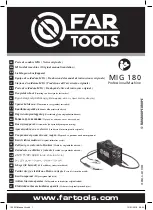
TROUBLE
REMEDY
Unit completely inoperative.
1. Turn power switch on.
2. Check F3 fuse if using 115/24 VAC transformer option.
3. If using 115/24 VAC transformer option check to see if transformer was
installed properly.
4. Check F2 fuse if operating from a 24 VAC power source.
5. Check control cord plugs and connections.
6. Check input power to feeder.
Wire does not feed.
1. Check for proper drive roll size and proper drive roll tension.
2. Check for drive roll obstructions.
3. Check mig gun trigger, trigger leads, cord and plug.
4. Check fuses
5. Have an authorized service station check motor and PC board.
Wire feeds as soon as power is turned on.
1. Check mig gun trigger, trigger leads, cord and plug for shorted wires.
2. Check for shorted or frayed wires touching in RC2 receptacle.
Wire feeds erratically.
1. Readjust drive roll tension.
2. Spool brake too tight.
3. Wrong size drive rolls and or wire guides.
4. Worn drive rolls and or guides.
5. Inlet or outlet guide touching drive rolls preventing proper tension
adjustment.
5. Dirty mig gun liner.
6. Improperly installed mig gun liner.
7. Worn contact tube.
8. Worn drive roll axles and or drive gear bushings.
9. Have an authorized service station check motor and PC board.
Gas valve rattles loudly with erratic
1. Check for a short between the weld cable and the mig gun trigger leads.
or slow wire speed.
2. Check gas valve components for tightness.
Gas does not flow but wire feeds OK.
1. Check gas supply and flowmeter to see if they are on and allowing gas to flow.
2. Check to see if gas flow is reaching gas solenoid connection at feeder.
3. Check gas solenoid valve.
Motor runs slowly.
1. Check for correct input voltage.
2. Check for correct voltage to motor.
3. Have an authorized service station check the motor and PC board.
Wire feeder operates OK but will not weld.
1. Ground cable not or badly connected.
2. Weld cable not connected to wire feeder.
3. Power cable not connected to power block.
4. Contactor not being energized in power source.
Check:
A. K1 relay
B. TS1 jumper placement
C. Control cord wiring
®
®
®
®
11
10
Section 5
Maintenance
Section 6
Troubleshooting
WARNING
WARNING
Electrical shock can kill
A. DO NOT TOUCH LIVE
electrical parts.
B. Disconnect input power
before servicing.
Moving parts can main
Disconnect input power
before servicing.
Hot parts can burn
Allow for cooling periods.
Read and understand the safety information in Section 1 of this manual.
CAUTION
Maintenance should be performed by qualified personnel only.
DAILY
1. Clean drive rolls.
A. Clean with a towel and wire brush.
B. If a solvent is required use one that will leave
NO
residue.
C.
DO NOT USE
- penetrating oils or anti-spatter spray on drive rolls.
2. Inspect all connections to make sure that they are clean and tight.
3. Inspect all cables and hose for cracks, tears and frayed wires. Repair as necessary.
MONTHLY
1. Inspect and repair any cables or hoses that are cracked or frayed.
2. Replace any cables or hoses that have been overheated or that have more than one repair in any six foot section.
3. Blow out or vacuum any particles from the wire drive area.
4. Clean any buildup of metal particles on or around the drive roll shafts.
5. Replace any terminal connections that show to have arced out or cannot be tightened.
3 MONTHS
1. Remove hinged cover and blow out or vacuum component area
2. Inspect for wear and replace if necessary, drive and pressure rolls, roll axles, gears and gear bushings.
3. Disassemble ,inspect and repair or replace if necessary all control cord multi-pin plugs with frayed wire or deteriorated wire
insulation.
4. Replace inlet, intermediate and outlet guides.
5. Replace mig gun liner and connector plug "O" rings
6. Replace unreadable labels.
OVERLOAD PROTECTION
Disconnect all electrical power before checking fuses.
FUSES:
F1
- 7A -Fast Acting
Protects motor from overload
F2
- 7A - Slo-Blo
For wire feeder overload protection when operating on
24VAC power.
F3
- 3A - Slo-Blo
USED ONLY WITH 115/24 VAC TRANSFORMER INSTALLED
Protects wire feeder from overload
Troubleshooting should only be done by qualified personnel
with a working knowledge of electrical circuits.
Summary of Contents for PRO II
Page 15: ... 13 Section 6 Parts PARTS MANUAL ...
Page 20: ......






































